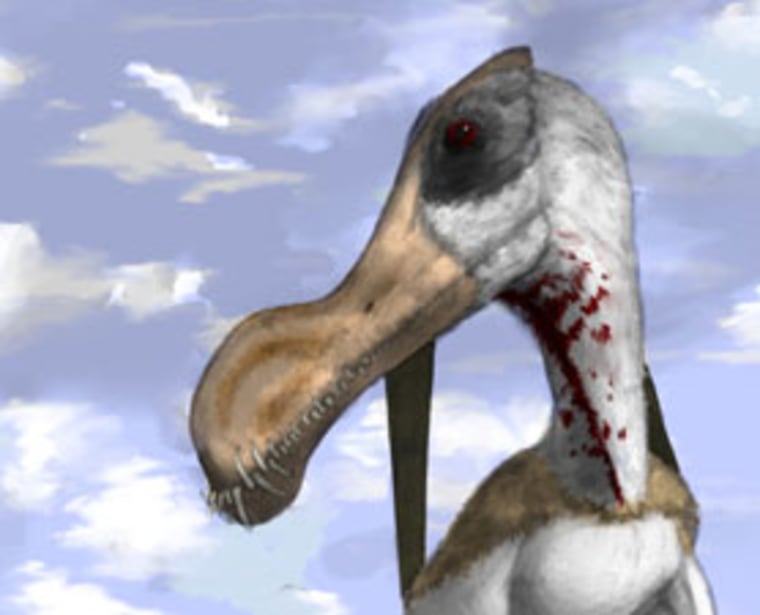Paleontologists have identified the world’s largest toothed pterosaur, which probably used its enormous pearly whites to scare off others.
The species, Coloborhynchus capito, is also now the world’s largest known toothed pterosaur, with a wingspan up to around 23 feet. A paper describing the prehistoric flying reptile will be published in the April issue of the journal Cretaceous Research.
PHOTOS: Dinosaur Feathers Found in Amber
“The first two teeth of each jaw projected forwards and may have been 3 inches long, and the two teeth behind it would have been a bit longer at 4 inches,” co-author David Martill, a professor in the University of Portsmouth’s Palaeobiology Research Group, told Discovery News.
“Together (the teeth) formed a sort of rosette that interlocked when the jaws were closed,” he added, saying that they might have been used in “threatening displays" and for catching fish.
Martill and colleague David Unwin of the University of Leicester made the discovery after analyzing a fragmentary, yet toothy, fossil housed within the collections of the Natural History Museum, London.
The fossil was unearthed from the Cretaceous Cambridge Greensand of eastern England, revealing that the pterosaur lived around 100 million years ago during what is known as the Albian stage.
During that time, Cambridge was under the sea. But Martill said there might have been a low island to the south where London is now. The climate was tropical then. Based on other fossil finds, the region was teaming with life. Fish, ichthyosaurs, plesiosaurs, crocodiles, turtles, dinosaurs (including prehistoric birds), and different types of pterosaurs all lived in the area.
Unlike dinosaurs, which live on today through birds, pterosaurs have no modern day descendants. They were “a sort of cousin to dinosaurs,” according to Martill, and they bit the earthly dust 65.5 million years ago, when the world’s non-avian dinosaurs also went extinct.
Darren Naish, a palaeozoologist at the University of Southampton, told Discovery News that researchers have been interested in the size extremes of pterosaurs, since these animals were often gigantic and yet could also fly. The new paper, he said, tests claims that toothed pterosaurs grew to huge sizes.
Both he and Martill agree that one of the biggest known pterosaurs was Quetzalcoatlus, with a wingspan that could have extended 32 feet.
While the new toothy pterosaur was big, “it isn’t in the same league as the giant azhdarchids (toothless pterosaurs). So we can now say with confidence that toothed ornithocheirids did evolve very large sizes, but so far as we know they did not reach the super-enormous size of those giant azhdarchids.”
NEWS: Nest Full of Baby Dinosaurs Found
Naish said Coloborhynchus opens up a lot of interesting questions, such as whether or not certain pterosaurs were “trapped by some sort of glass ceiling that prevented them from evolving gigantic size.”
Other scientists look to pterosaurs to learn more about flight dynamics and what kind of structures can efficiently become airborne.
Naish suggested that the new find is surprising because “the fossil they use is a really ugly chunk of an ornithocheird’s snout,” but it provided enough data to make the determinations.
Martill seems to share Naish’s opinion, as he said the new study shows “the importance of old museum collection findings and the importance of even the scrappiest fossils.”
